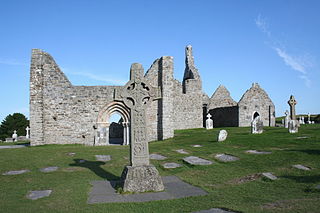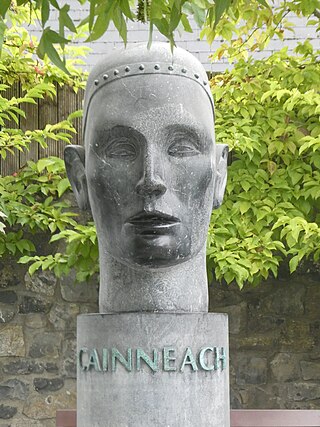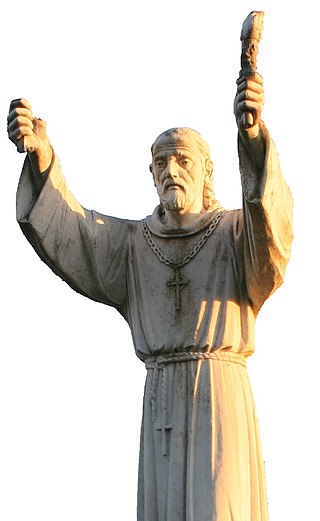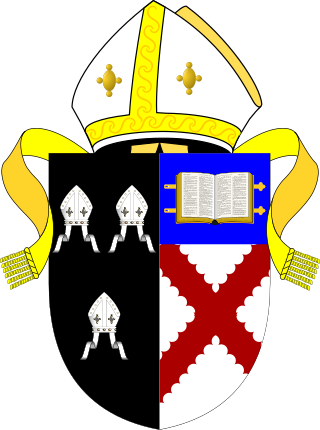

Clonard Abbey (Irish : Mainistir Chluain Ioraird, meaning "Erard's Meadow") was an early medieval monastery situated on the River Boyne in Clonard, County Meath, Ireland.


Clonard Abbey (Irish : Mainistir Chluain Ioraird, meaning "Erard's Meadow") was an early medieval monastery situated on the River Boyne in Clonard, County Meath, Ireland.
The monastery was founded in about 520 by Saint Finnian, who initially constructed a single cell at the site. [1] The original site may have been at nearby Ard Relec. [2] According to medieval chronicles, Finnian was led to the site by an angel who told him that it would be the place of his resurrection. He was well-travelled, and based his monastery on the training he received at Tours and Llancarfan. [3] Finnian was buried on the site after his death in about 549. During the sixth century, some of the most significant names in the history of Irish Christianity (who would go on to be known as the Twelve Apostles of Ireland) studied at the monastery.[ citation needed ]
Clonard was situated on the Esker Riada, Ireland's main east-west road in early medieval times, adding to its prominence. However, it was also on the boundary between the kingdoms of Leinster and Meath that were occasionally at war.[ citation needed ]
From the eighth century onwards, Clonard came under the control of various rival political dynasties, [2] and by the mid-ninth century, it was the leading church of the Irish midlands. The abbot of Clonard led the clergy of the midlands in the same fashion that the abbot of Armagh led those in the north. [4] During its heyday, a hymn written in Finnian's honour claimed that the monastery's school housed 3,000 pupils receiving religious instruction at any given time. [5]
A great part of the abbey erected by St. Finian was burnt in 764. Like many monastic sites in Ireland, Clonard suffered heavy losses under the Viking raids of the ninth through eleventh centuries. In the year 838 the Danes destroyed it and put the clergy to the sword. They returned again in 888. [6] In 939, Ceallachan, King of Cashel, assisted by the Danes of Waterford, plundered the abbey. In 970, Donell, son of Murcha, pillaged and burnt Clonard. [7]

From the Synod of Ráth Breasail (1111), it was the centre of the new see of Clonard, to which, were added the bishoprics of Trim, Ardbraccan, Dunshaughlin, and Slane, indicating its importance at the time. This was confirmed at the Synod of Kells in 1152. In 1113, Connor, King of Munster, plundered Meath and forcibly carried off the riches of the whole province, which had been lodged for safety in the abbey church. [7] A great part of the abbey, and all the library, was consumed by an accidental fire in 1143. The abbey and town were despoiled and burnt in 1170, by M'Murcha, aided by Earl Strongbow and the English, and having been afterwards rebuilt, they suffered a similar fate in the year 1175. [6] That same year, Walter, son of Hugh de Lacy, erected, probably on the ruins of the ancient abbey, an Augustinian monastery. Clonard fell into decline during the twelfth century, and in 1202, the Norman bishop de Rochfort transferred the see from Clonard to Trim in the new Diocese of Meath. [2]
Very little remains of the site today. From the air, the outlines of some wall boundaries and other earthworks are visible.

See Annals of Inisfallen (AI)
The Diocese of Meath is an Irish diocese which took its name after the ancient Kingdom of Meath. In the Roman Catholic Church it still exists as a separate diocese, but in the Church of Ireland it has been united with other dioceses.

Rosscarbery is a village and census town in County Cork, Ireland. The village is on a shallow estuary, which opens onto Rosscarbery Bay. Rosscarbery is in the Cork South-West constituency, which has three seats.

Clonmacnoise is a ruined monastery situated in County Offaly in Ireland on the River Shannon south of Athlone, founded in 544 by Saint Ciarán, a young man from Rathcroghan, County Roscommon. Until the 9th century it had close associations with the kings of Connacht.
Fedelmid mac Crimthainn was the King of Munster between 820 and 846. He was numbered as a member of the Céli Dé, an abbot of Cork Abbey and Clonfert Abbey, and possibly a bishop. After his death, he was later considered a saint in some martyrologies.

Cainnech of Aghaboe (515/16–600), also known as Saint Canice in Ireland, Saint Kenneth in Scotland, Saint Kenny and in Latin Sanctus Canicus, was an Irish abbot, monastic founder, priest and missionary during the early medieval period. Cainnech is one of the Twelve Apostles of Ireland and preached Christianity across Ireland and to the Picts in Scotland. He wrote a commentary on the Gospels, which for centuries was known as the Glas-Choinnigh or Kenneth's Lock or the Chain of Cainnech.

Finnian of Movilla was an Irish Christian missionary. His feast day is 10 September.

Finnian of Clonard – also Finian, Fionán or Fionnán in Irish; or Finianus and Finanus in its Latinised form (470–549) – was one of the early Irish monastic saints, who founded Clonard Abbey in modern-day County Meath. The Twelve Apostles of Ireland studied under him. Finnian of Clonard is considered one of the fathers of Irish monasticism.

Terryglass is a village in County Tipperary, Ireland. The small town is located on the R493 regional road on the north-eastern shore of Lough Derg near where the River Shannon enters the Lough. It is a civil parish in the historical barony of Ormond Lower. It is also an Ecclesiastical parish in the Roman Catholic Diocese of Killaloe,. Terryglass won the Irish Tidy Towns Competition in 1983 and 1997.

The Twelve Apostles of Ireland were twelve early Irish monastic saints of the sixth century who studied under St Finnian at his famous monastic school Clonard Abbey at Cluain-Eraird, now Clonard in County Meath.

Emly or Emlybeg is a village in County Tipperary, Ireland. It is a civil parish in the historical barony of Clanwilliam. It is also an Ecclesiastical parish in the Roman Catholic Archdiocese of Cashel and Emly.
Clonard may refer to:

Clonard is a small village in County Meath, Ireland. It lies on the R148 regional road between the towns of Kinnegad and Enfield. This road was the main road between Dublin and Galway until the construction of the M4 motorway. It is still used by traffic avoiding the toll on the M4.

Saint Féchín or Féichín, also known as Mo-Ecca, was a 7th-century Irish saint, chiefly remembered as the founder of the monastery at Fore (Fobar), County Westmeath.

The United Dioceses of Meath and Kildare is a diocese in the Church of Ireland located in the Republic of Ireland. The diocese is in the ecclesiastical province of Dublin. Alone of English and Irish bishops who are not also archbishops, the Bishop of Meath and Kildare is styled "The Most Reverend".
Bishop of Clonmacnoise was the ordinary of the Roman Catholic episcopal see based at Clonmacnoise, County Offaly, Ireland. The bishops of Clonmacnoise appear in the records for the first time in the 9th century, although inferior in status to the Abbot of Clonmacnoise until the reformation of the Irish Church in the 12th century. After the Reformation, there were several parallel bishops placed by the Church of Ireland until the Diocese of Clonmacnoise was merged with Diocese of Meath to form the Diocese of Meath and Kildare in 1569. In the Roman Catholic Church, separate bishops continued longer. The diocese came under the administration of the Bishop of Ardagh between 1688 and 1725, before the provision of Stephen MacEgan in 1725. Although MacEgan was translated to Meath in 1729, he continued to administer Clonmacnoise separately until his death in 1756, after which the see was finally merged into the Roman Catholic Diocese of Ardagh and Clonmacnoise.
Events from the 7th century in Ireland.
Events from the 6th century in Ireland.

Eóganacht Chaisil were a branch of the Eóganachta, the ruling dynasty of Munster between the 5th and 10th centuries. They took their name from Cashel which was the capital of the early Catholic kingdom of Munster. They were descended from Óengus mac Nad Froích, the first Christian King of Munster, through his son Feidlimid mac Óengusa.
The Roman Catholic Diocese of Clonard was a medieval diocese in Ireland until its 1202 suppression, which became a modern Latin Catholic titular see.
The Abbot of Clonard was the monastic head of Clonard Abbey, which is in modern-day County Meath, Ireland. The abbey was founded by Saint Finnian in the early sixth century. After the death of Saint Finnian, the abbots bore the title "Comarbai Finnéin". However, the title was ambiguous, since it may refer to the abbots of Moville, County Down, founded by Finnian nepos Fiatach. The abbots of Clonard were sometimes called 'coarbs of Finnian and Mo Cholmóc'. Until the early twelfth century, a few of the abbots and some others at Clonard Abbey were consecrated bishops, but this did not necessarily mean they were bishops of Clonard, since the diocese of Clonard was not established until the Synod of Rathbreasail in 1111.